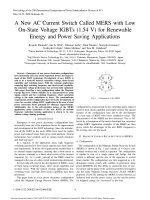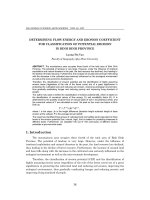Energy and food
Bạn đang xem bản rút gọn của tài liệu. Xem và tải ngay bản đầy đủ của tài liệu tại đây (1.52 MB, 24 trang )
Summer 2009 Workshop
in Biology and Multimedia
for High School Teachers
Life Sciences-HHMI Outreach. Copyright 2009 President and Fellows of Harvard College.
• Energy is a critical part of your
everyday life.
• Energy is either released or
absorbed in a chemical reaction.
This occurs when the bonds
between the atoms are broken
and then the atoms rearranged.
• The food you eat is the fuel which
will provide the energy you need
to sustain life.
/>
Life Sciences-HHMI Outreach. Copyright 2009 President and Fellows of Harvard College.
/>
Life Sciences-HHMI Outreach. Copyright 2009 President and Fellows of Harvard College.
Reactions that absorb energy are called
Life Sciences-HHMI Outreach. Copyright 2009 President and Fellows of Harvard College.
Reactions that
release energy are
called
/>
Life Sciences-HHMI Outreach. Copyright 2009 President and Fellows of Harvard College.
Digestion is the
physical and
chemical
processes used to
break down food
into smaller
molecules that can
be absorbed by
the human body.
/>g
/>
Look
Life Sciences-HHMI Outreach. Copyright 2009 President and Fellows of Harvard College.
RELEASE
ENERGY
Metabolism refers to all the
chemical reactions within an
organism that breakdown
molecules to release energy
and all the reactions that use
energy to build complex
molecules. These reactions are
referred to as
ABSORB
ENERGY
Life Sciences-HHMI Outreach. Copyright 2009 President and Fellows of Harvard College.
/>
When we speak of
energy we are
talking ….
Catabolism is the process
where larger molecules are
broken down into smaller
molecules releasing energy.
The molecules are broken
down into either simple
sugars, glycerol and fatty acids
or amino acids. This process is
exothermic .
/> />
Life Sciences-HHMI Outreach. Copyright 2009 President and Fellows of Harvard College.
Anabolism is the process
where smaller molecules are
combined to form larger more
complex molecules. This
process requires energy so it
is considered an
endothermic reaction .
/>
Life Sciences-HHMI Outreach. Copyright 2009 President and Fellows of Harvard College.
The change in energy is measured in
terms of heat. The amount of energy
(heat) that is contained within the
bonds of the reactants is compared to
the amount of energy (heat) that is
contained within the bonds of the
products. This is referred to as the
H.
This symbol means the difference in Enthalpy.
Life Sciences-HHMI Outreach. Copyright 2009 President and Fellows of Harvard College.
ENTHALPY
• Endothermic reactions always have a positive
H.
• Exothermic reactions always have a negative
H.
Life Sciences-HHMI Outreach. Copyright 2009 President and Fellows of Harvard College.
• Enthalpy changes that are measured when reactants are in
their standard states are called STANDARD ENTHALPY
CHANGES.
• STANDARD ENTHALPIES are denoted by
states are at 25˚ C and 1 atm of pressure.
∆ H˚. Standard
• The enthalpy change in a reaction is directly related to the
amount of reactants.
Life Sciences-HHMI Outreach. Copyright 2009 President and Fellows of Harvard College.
Hess’s Law
states that if a series of
reactions are added together,
the enthalpy change for the
net reaction is the same as the
sum of the individual reactions.
Huh?
More simply put:
2+2=4
is the same as
1+1+1+1=4
Life Sciences-HHMI Outreach. Copyright 2009 President and Fellows of Harvard College.
• The subject of calorimetry studies the flow of heat and heat
measurements.
• Every object has the ability to absorb heat. The amount of heat that
is absorbed is referred to as the heat capacity.
• The heat capacity is the amount of heat required to raise the
temperature by 1˚C.
• The heat capacity depends on the composition and the amount of the
substance,
Life Sciences-HHMI Outreach. Copyright 2009 President and Fellows of Harvard College.
The heat capacity of one gram of a
substance is referred to as the
SPECIFIC HEAT.
Life Sciences-HHMI Outreach. Copyright 2009 President and Fellows of Harvard College.
The specific heat of
water is 4.184 J/g·Cº.
This means that
4.184 J of heat is
needed is needed to
raise 1 gram of water
1ºC.
1calorie= 4.184 J
1000calories=1
kilocalorie or CAL.
/>
Life Sciences-HHMI Outreach. Copyright 2009 President and Fellows of Harvard College.
• Kilocalories are used in
nutrition.
• Calorimeters are used to
figure out the calories in food
sources.
/>
/>gif
Life Sciences-HHMI Outreach. Copyright 2009 President and Fellows of Harvard College.
• The catabolism of food is an oxidative reaction.
• Most of our energy comes from Calories found in
• C H O (s) + 6 O (g) → 6 CO (g) + 6 H O (l)
6
12
6
2
2
fat and sugar.
2
∆H° = -2816 kJ
EXOTHERMI
C
Life Sciences-HHMI Outreach. Copyright 2009 President and Fellows of Harvard College.
C57H110O6 (s) + 163/2 O2 (g) → 57 CO2 (g) + 55 H2O (l).
∆rH° = -37.8 x 104 kJ
EXOTHERMIC
Twice the energy as proteins and
glucose!
Life Sciences-HHMI Outreach. Copyright 2009 President and Fellows of Harvard College.
Catabolism
Fuels
and
O2
CO2
water
ATP
ADP
P
Cellular
Processes
Anabolism
IN SUMMARY!!!
Life Sciences-HHMI Outreach. Copyright 2009 President and Fellows of Harvard College.
Life Sciences-HHMI Outreach. Copyright 2009 President and Fellows of Harvard College.









